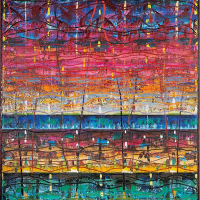52. MICHAEL JOHNSON

A contemporary of Brett Whiteley (1939-1992), Sidney Nolan (1917-1992) and John Olsen (born 1928), Michael Johnson occupies a vital position within the history of abstract painting in Australia. Born in Sydney, Johnson attended the Julian Ashton Art School followed by The National Art School during the late 1950s, often embarking on painting trips around rural New South Wales with Brett Whiteley, allowing a lifelong friendship to flourish. Like many of his contemporaries, Johnson later travelled to Europe in the early 1960s, settling at Brian Wall (born 1931) and Anthony Caros (1924-2013) studio and residing there for seven years. He managed to hold steadfast in his practice throughout the progressive changes and shifts to figurative and semi-abstract movements during this time, instead solidifying his love for colour, form and space to produce highly distilled abstract works that created the foundation for his work today.
Although moving through various forms of abstraction throughout his career, Johnson remained inherently fascinated by the exploration of colour and the visual experience of art rather than a literal encounter. During the early 1980s he moved from geometric vertical forms to horizontal zones that embellished the canvas with a deep painterly quality. It is this painterly quality where the viewer becomes acutely aware of the medium working as more than just paint on a canvas but a tactile entity in its own right, with Johnson famously stating, if the canvas rots, the paint will just stand up like a sheet.1 It was throughout this time and on to the turn of the century that he established his geometric rhythm that provides a duality of structure, a vivid chaos, to his work.
Realised at the pinnacle of Johnsons career, Celtic Spell is a stunning illustration of an artist who has remained unwavering in his practice throughout his career, richly adding to the Australian art scene since the late 1950s. Celtic Spell provides a definitive example of Johnsons metaphysical arrangement of colour. The use of colour specific zones dominates the composition providing a brilliant display of explosive vibrancy, yet an inherent understanding of controlled energy. Systematically dividing the canvas into four distinct zones pays homage to Johnsons lifelong infatuation with nature and how the elements of different environments intertwine significantly with one another. Water, air and earth are presented in a highly textural, voracious manner - yet a sense of manicured precision is captured, moving away from merely a celebration of surface colour and implying an archeology of feeling, an unfathomable sense of the metaphysical.2 As Johnson explained, I want the impact to engage the senses, play with time and spatial awareness. My paintings are not an object capturing scenery; it is a sensory experience on its own terms.3 Johnsons work truly captures his intent; it is raw and intuitive, humbly portraying his unwavering relationship with Australias natural habitat through explosive colour-play and an unparalleled visual experience.
Footnotes:
1. I still have more painting to do, Sydney Morning Herald, Sydney, 24 March 2007, p.11
2. Pearce, B., Michael Johnson, Beagle Press, Sydney, 2004, p.76
3. Bond, A. & Lynn, V., Michael Johnson: Paintings 1968 1988, Art Gallery of New South Wales, Sydney, 1989, pp. 3-6
Clementine Retallack BA